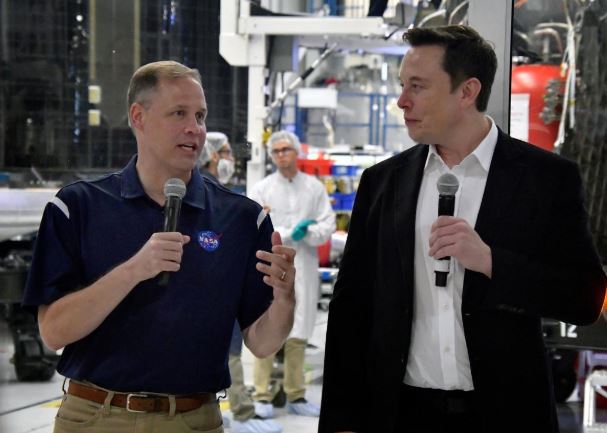NASA aims for first manned SpaceX mission in first-quarter 2020
SpaceX’s new Crew Dragon astronaut capsule will be ready for its first manned flight into orbit in the first quarter of next year provided “everything goes according to plan” in upcoming tests, NASA chief Jim Bridenstine said on Thursday.

Hawthorne: SpaceX’s new Crew Dragon astronaut capsule will be ready for its first manned flight into orbit in the first quarter of next year provided “everything goes according to plan” in upcoming tests, NASA chief Jim Bridenstine said on Thursday.
The pronouncement of a revised time frame signaled NASA believes SpaceX is getting the Crew Dragon project back on track following an explosion during a ground test in April and technical challenges with its re-entry parachute system.
Also Read: Chandrayaan 2 may be hiding in shadows, says NASA after capturing landing site
Bridenstine said successful development of the capsule was key to achieving NASA’s top priority - the resumed “launching of American astronauts on American rockets from American soil” for the first time since the space shuttle program ended in 2011. The NASA administrator spoke to reporters at the end of a visit to the SpaceX headquarters in Hawthorne, California, just outside Los Angeles, where chief executive Elon Musk led him on a tour of the sprawling manufacturing plant. Their joint appearance by a giant glass-enclosed “clean room” where engineers were working on a Crew Dragon marked a show of unity following a rare public spat over delays in the project.

NASA and SpaceX had previously aimed to launch the Crew Dragon on an initial test flight carrying two astronauts to the International Space Station in 2019. The revised time line hinges on a series of system tests that SpaceX hopes to conduct by year’s end, Bridenstine said. These include a high-altitude test of an in-flight abort system designed to propel the crew capsule to safety in the event of a rocket failure on the way to orbit.
Also Read |
NASA's Mars 2020 rover to search for signs of past microbial life
The schedule also includes at least 10 more mid-air “drop tests” to gauge the resilience and performance of parachutes used to slow the capsule’s descent into the ocean after it re-enters the atmosphere from space.

GET THE PARACHUTES RIGHT
“If everything goes according to plan, it would be the first quarter of next year,” Bridenstine said when asked how soon he the capsule would be ready to fly astronauts into orbit. He was quick to add that the new time line could slip again.
“We are not going to take any undue risk,” he said, standing beside Musk and the two astronauts slated to fly aboard the Crew Dragon - Doug Hurley and Bob Benkoe.

Bridenstine also praised SpaceX for its “fail fast, then fix” approach to spacecraft development, an ethos he said that differed from the cultures of other NASA contractors. The National Aeronautics and Space Administration is paying commercial launch companies SpaceX and Boeing Co (BA.N) $6.8 billion to build rocket-and-capsule systems enabling NASA to resume human space travel with U.S.-made hardware. SpaceX has so far never flown humans into orbit, only cargo. But the company successfully launched an unpiloted Crew Dragon to the International Space Station in March. Musk said overcoming problems with re-entry parachutes had proved especially challenging.
Also Read | Astronomers measure expansion rate of Universe
“It’s a pretty arduous engineering job to get the parachutes right,” Musk said, declaring that Crew Dragon’s parachutes will be at least twice as safe as those used during NASA’s Apollo moon missions.
Also Read: Caught in the act: a black hole rips apart an unfortunate star
He expected that “testing will be complete and hardware at the Cape (Canaveral) by the end of December.” The top executive for Boeing’s rival Starliner program, John Mulholland, said on Wednesday that its own key test of an abort system was slated for Nov. 4, while its unpiloted orbital test flight was set for Dec. 17. Under that time frame, the first Starliner manned mission is all but certain to slip into 2020. NASA is currently paying Russia about $80 million per seat for rides to the space station.
Bridenstine said the agency was “still buying seats” for ride-alongs aboard Russia’s Soyuz as an “insurance policy” against future delays in U.S. crew capsule development. While providing few concrete details on their joint investigation into an explosion during a ground test of Crew Dragon’s abort thrusters in April, Musk said such setbacks were inevitable in rigorous testing of complex systems. Bridenstine’s visit came after he and Musk had clashed over the past two weeks, with the NASA chief chiding Musk on Twitter for celebrating a milestone on SpaceX’s deep-space Starship rocket while the Crew Dragon project remained delayed.
Bridenstine sought to bury the hatchet on Thursday, saying he was merely “signaling” to SpaceX and other NASA contractors that “we need more realism built in to our development time frames.”(Reuters)
 Dynamite News
Dynamite News 